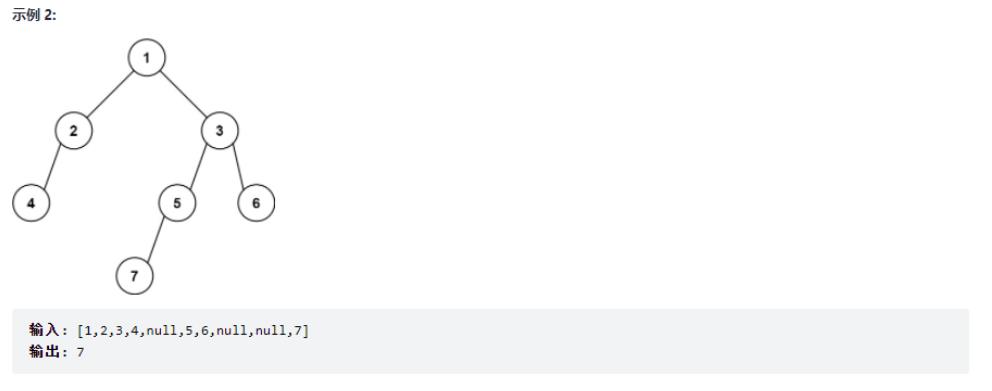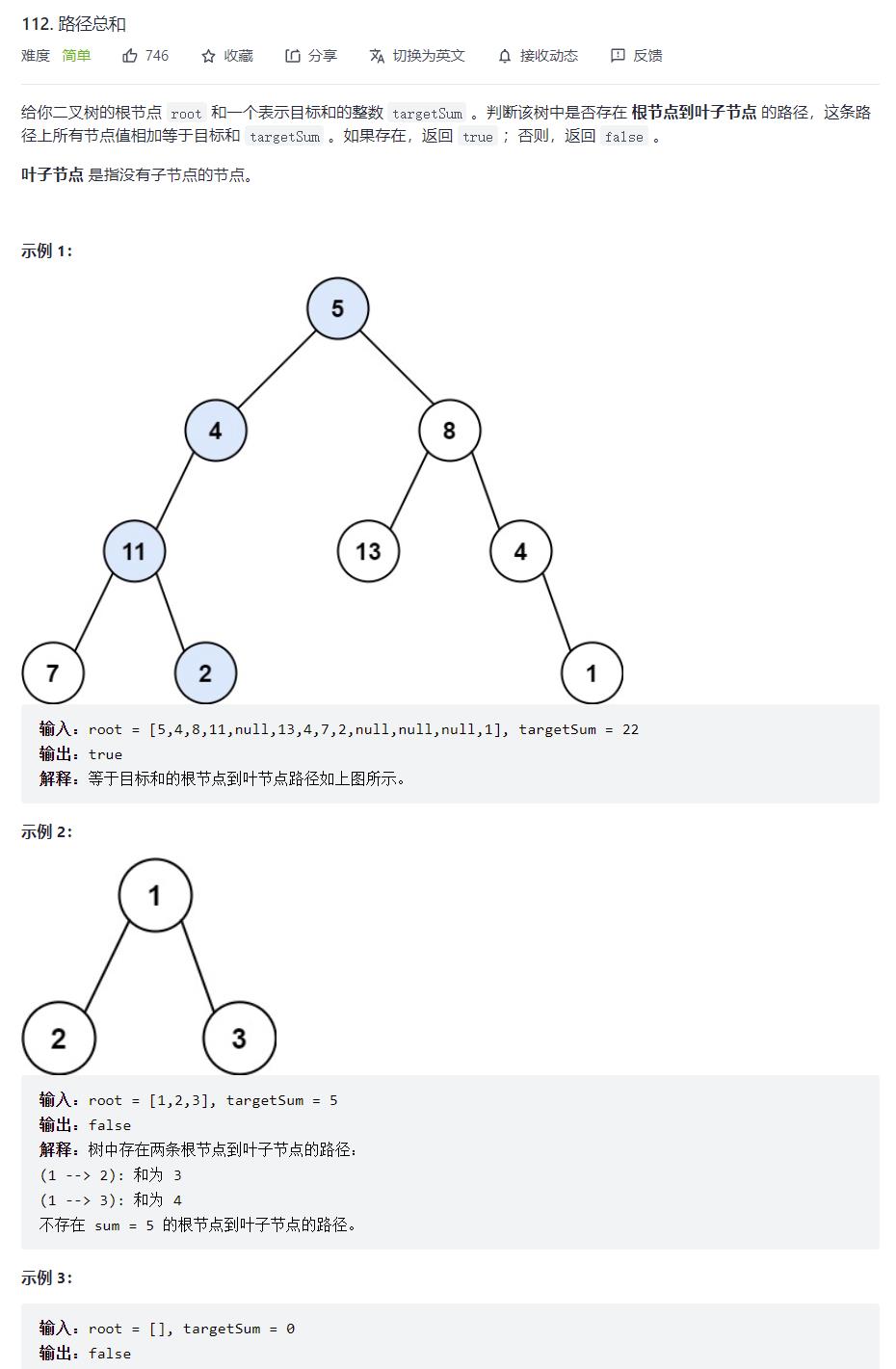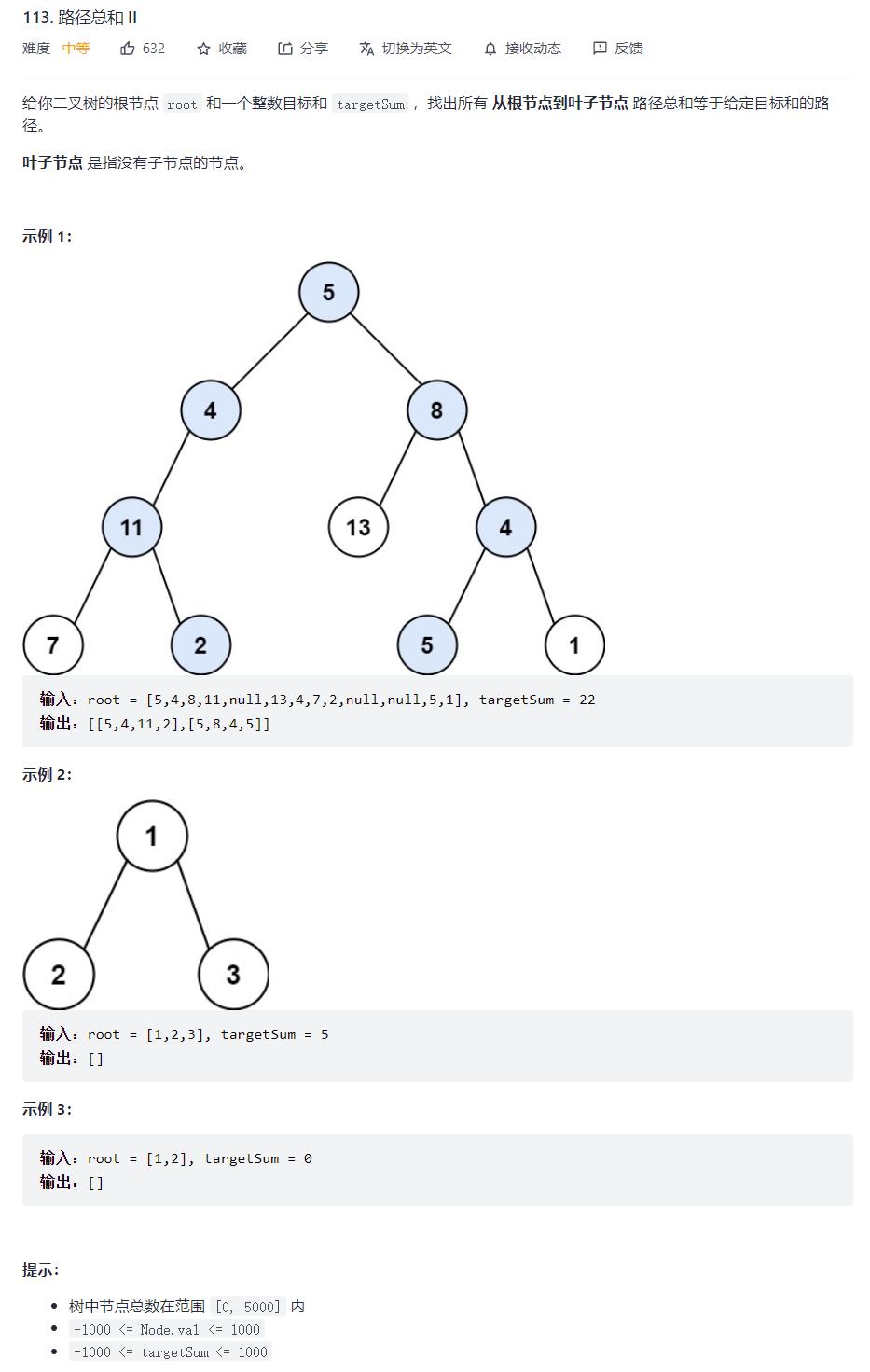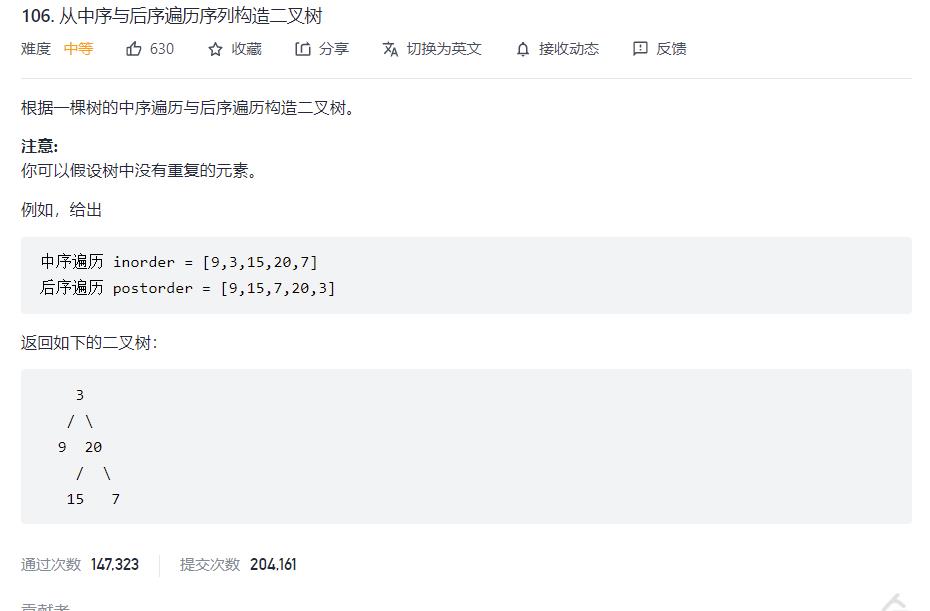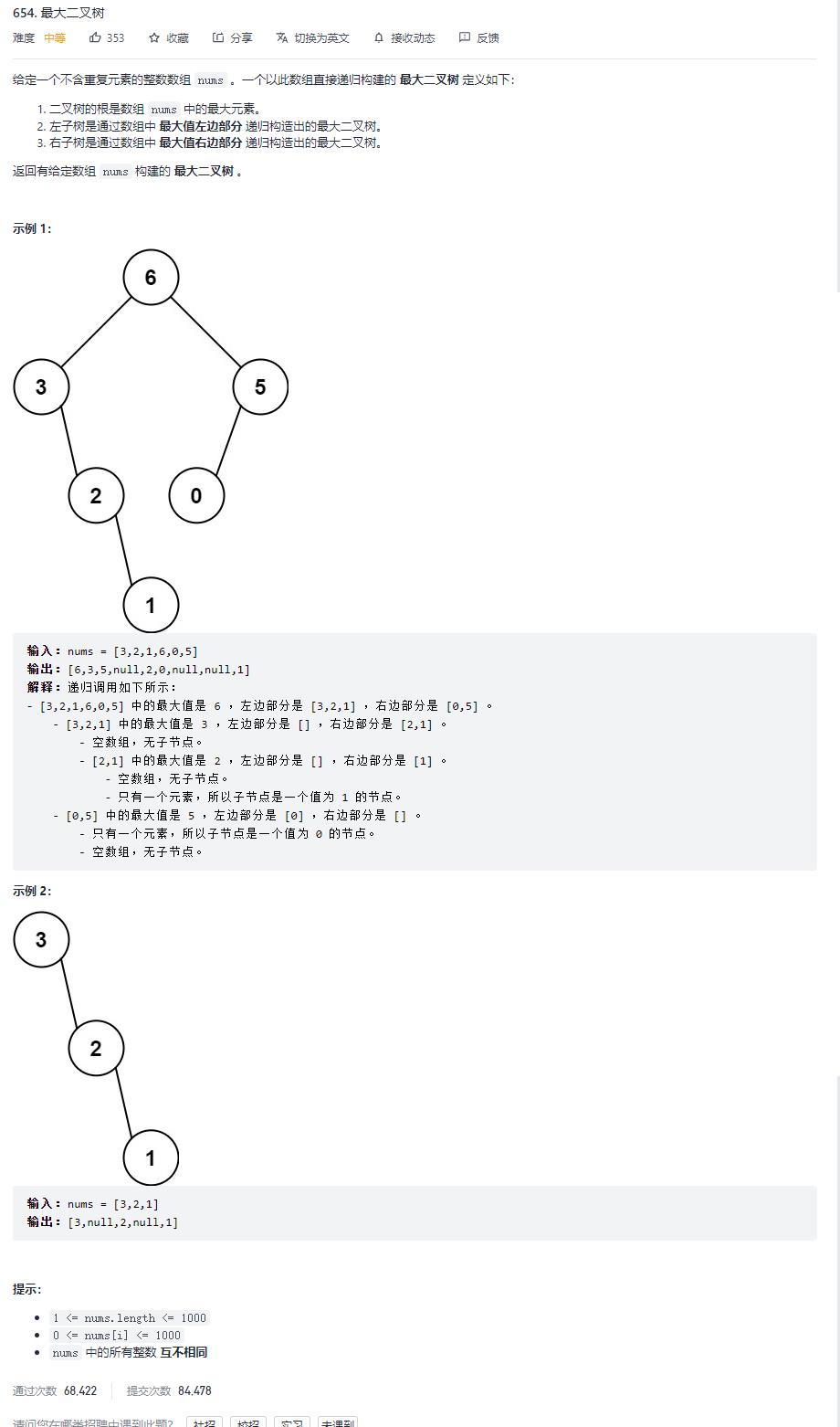刷题那些事Leetcode精选二叉树例题+解析
Posted 温文艾尔
tags:
篇首语:本文由小常识网(cha138.com)小编为大家整理,主要介绍了刷题那些事Leetcode精选二叉树例题+解析相关的知识,希望对你有一定的参考价值。
🙏亲爱的朋友,如果对你有帮助,给博主一个免费的点赞以示鼓励把QAQ☺
这里是温文艾尔の刷题学习之路- 🙏作者水平欠佳,如果发现任何错误,欢迎批评指正
- 👋博客主页 温文艾尔の学习小屋
- 👋更多文章请关注温文艾尔主页
- 👋超详细Leetcode刷题解析!
- 👋更多文章:
- 👋Leetcode刷题日记精选例题 (附代码+链接)1
- 👋LeetCode刷题日记精选例题(附代码+链接)2
- 👋LeetCode刷题日记精选例题(附代码+链接)3
- 👋LeetCode刷题日记精选例题(附代码+链接)4
- 👋LeetCode刷题日记精选例题-双指针经典问题总结
- 👋LeetCode刷题日记精选例题(解析+代码+链接)5
- 👋11道精选经典LeetCode例题让你彻底搞懂二叉树的广度优先遍历
- 👋LeetCode刷题日记精选例题(附代码+链接)6

👋计算二叉树所有左叶子之和
解题思路:这道题我们首先要清楚,什么是左叶子
左叶子:位于父节点的左子树,且自身没有左右节点
如下面这幅画(画的丑见谅0.0)
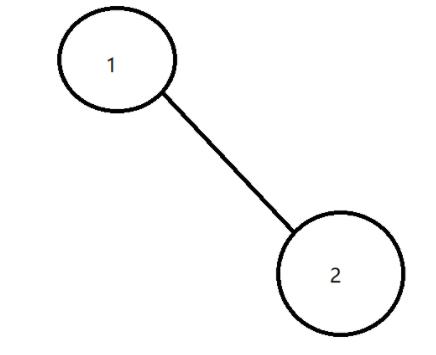
2就不是左叶子,虽然他没有子节点,但是他不在1节点的左边
清楚了什么是左叶子,我们就可以真正解决这道题,那么我们可以想到,某节点的左子树可能存在左叶子,它的
右子树也可能存在左叶子,它的左子树的左子树也可能存在左叶子

我们用深度优先搜索,后序遍历(左右中)判断就会比较方便,只需要一直向子树中递归就行
代码奉上
public int sumOfLeftLeaves(TreeNode root)
if (root==null)return 0;
int left = sumOfLeftLeaves(root.left);
int right = sumOfLeftLeaves(root.right);
int mid = 0;
if (root.left!=null&&root.left.left==null&&root.left.right==null)
mid=root.left.val;
return mid+left+right;

👋找树左下角的值
解题思路:本题使用层寻遍历最简单也最方便理解,因为只需要一层一层遍历然后统计最后一行的第一个数据就可以
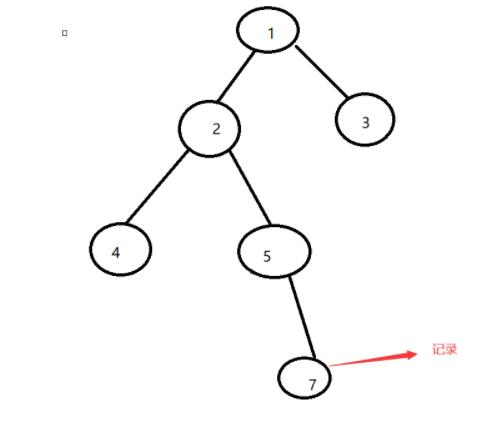
public int findBottomLeftValue(TreeNode root)
Queue<TreeNode> queue = new LinkedList<>();
queue.offer(root);
int left = 0;
while (!queue.isEmpty())
int len = queue.size();
for (int i=0;i<len;i++)
TreeNode poll = queue.poll();
if (i==0) left=poll.val;
if (poll.left!=null) queue.offer(poll.left);
if (poll.right!=null) queue.offer(poll.right);
return left;

👋路径总和i
题解思路:
深度优先搜索比较适合本题,我们遍历从根节点到叶子结点的路径,看看综合与targetSum是否相等,在进行递归的时候可以把每个节点的值都记录下来,如果不等的话就进行回溯
既然确定要使用递归,那么就必须确定以下三个要素
- 确定递归函数的
参数和返回值 - 确定
终止条件 - 确定单层递归的
逻辑
第一个要素,我们可以确定,参数时肯定要有
- 根节点
root,不然没办法递归了 - 有一个值
count来记录路径的和,返回值的话,我们可以看到leetcode题目上返回值为boolean类型,我们的返回值也会是boolean类型 targetSum
第二个要素,终止条件肯定是到达根节点
- 路径的和与targetSum不相等,终止,进行回溯
- 路径的和与targetSum相等,终止,直接返回
第三个要素,如果有左子节点就向左递归,如果有右子节点就向右递归,记得回溯的时候把count减去未达标节点的val
public boolean hasPathSum(TreeNode root, int targetSum)
if (root==null) return false;
return check(root,root.val,targetSum);
private boolean check(TreeNode root, int count,int target)
if (root.left==null&&root.right==null&&count!=target)
return false;
if (root.left==null&&root.right==null)
return true;
if (root.left!=null)
count+=root.left.val;
if(check(root.left,count,target)) return true;
count-=root.left.val;
if (root.right!=null)
count+=root.right.val;
if (check(root.right,count,target))return true;
count-=root.right.val;
return false;

👋路径总和ii
解题思路:
这题和上一题的模式是差不多的但是递归三要素却不一样,我们不仅需要判断值是否满足,还需要把所有符合条件的路径记录下来
我们重新规范一下本题的递归三要素
- 确定递归函数的
参数和返回值 - 确定
终止条件 - 确定单层递归的
逻辑
第一个要素,除了root,count,targetSum,我们还需要传进去一个集合Biglist用来保存所有正确的路径,还需要一个集合Smllist用来记录每次经过的节点值,递归不需要返回值
第二个要素,终止条件肯定是到达根节点
- 路径的和与targetSum不相等,终止,进行回溯
- 路径的和与targetSum相等,终止,将路径记录在集合中
第三个要素和上一题相同

public List<List<Integer>> pathSum(TreeNode root, int targetSum)
List<List<Integer>> Biglist = new ArrayList<>();
if (root==null)return Biglist;
List<Integer> smllist = new ArrayList<>();
check(root,targetSum,Biglist,smllist);
return Biglist;
private void check(TreeNode root, int targetSum, List<List<Integer>> biglist, List<Integer> smllist)
smllist.add(root.val);
if (root.left==null&&root.right==null)
if (targetSum-root.val==0)
biglist.add(new ArrayList<>(smllist));
else
return;
if (root.left!=null)
check(root.left,targetSum-root.val,biglist,smllist);
smllist.remove(smllist.size()-1);
if (root.right!=null)
check(root.right,targetSum-root.val,biglist,smllist);
smllist.remove(smllist.size()-1);

👋从中序与后序遍历序列构造二叉树
题解思路:观察后序遍历,我们发现后序遍历数组的最后一个元素就是根节点n,而n在中序遍历的位置刚好将切割中序遍历数组,将其一分为二,n的左边为左子树,n的右边为右子树,然后进行递归
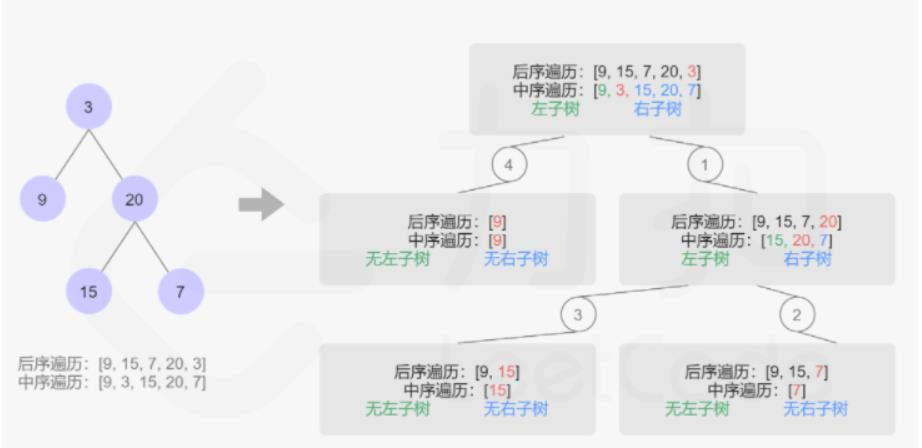
以中序遍历 inorder = [9,3,15,20,7] 后序遍历 postorder = [9,15,7,20,3] 为例
- 第一步找到3在inorder中的位置,位置为1
- 将inorder以索引1为分界点进行切割[9],[15,20,7]分别进行递归
- 当数组中只有一个元素时证明它是叶子结点,直接返回
- 当数组中有多个元素时例如[15,20,7],以20在中序数组中的位置再次进行切割递归,直到找到叶子结点
public Map<Integer,Integer> map = new TreeMap<>();
public TreeNode buildTree(int[] inorder, int[] postorder)
//放到map中方便寻找下标
for (int i = 0; i < inorder.length; ++i)
map.put(inorder[i],i);
return Mybuild(inorder,0,inorder.length-1,postorder,0,postorder.length-1);
private TreeNode Mybuild(int[] inorder, int inLeft, int inRight, int[] postorder, int posLeft, int posRight)
if (inLeft>inRight)
return null;
int index = map.get(postorder[posRight]);//获得后序遍历数组中节点在中序遍历中的位置
TreeNode root = new TreeNode(postorder[posRight]);
root.left = Mybuild(inorder,inLeft,index-1,postorder,posLeft,posLeft+(index-inLeft)-1);
root.right = Mybuild(inorder,index+1,inRight,postorder,posLeft+(index-inLeft),posRight-1);
return root;

👋从前序与中序遍历序列构造二叉树
解题思路:解题思路可以仿照第五题,我们发现前序遍历数组的第一个元素是中间节点,由此我们可以得到中间节点在中序遍历数组中的下标index,根据Index将中序遍历数组一分为二,左边即为左子树,右边就是右子树,进行递归
public TreeNode buildTree(int[] preorder, int[] inorder)
return MyBuild(preorder,0,preorder.length-1,inorder,0,inorder.length-1);
private TreeNode MyBuild(int[] preorder, int preLeft, int preRight,int[] inorder, int inLeft, int inRight)
if (inLeft>inRight||preLeft>preRight)
return null;
int idx = inLeft;
//得到首节点下标
int rootIndex = 0;
for (int i=inLeft;i<=inRight;i++)
if (preorder[preLeft]==inorder[i])
rootIndex=i;
break;
//创建首结点
TreeNode root = new TreeNode(preorder[preLeft]);
root.left=MyBuild(preorder,preLeft+1,preLeft+(rootIndex-inLeft),inorder,inLeft,rootIndex-1);
root.right= MyBuild(preorder,preLeft+(rootIndex-inLeft)+1,preRight,inorder,rootIndex+1,inRight);
return root;

👋最大二叉树
递归调用如下所示:
- [3,2,1,6,0,5] 中的最大值是 6 ,左边部分是 [3,2,1] ,右边部分是 [0,5] 。
- [3,2,1] 中的最大值是 3 ,左边部分是 [] ,右边部分是 [2,1] 。
- 空数组,无子节点。
- [2,1] 中的最大值是 2 ,左边部分是 [] ,右边部分是 [1] 。
- 空数组,无子节点。
- 只有一个元素,所以子节点是一个值为 1 的节点。
- [0,5] 中的最大值是 5 ,左边部分是 [0] ,右边部分是 [] 。
- 只有一个元素,所以子节点是一个值为 0 的节点。
- 空数组,无子节点。
- [3,2,1] 中的最大值是 3 ,左边部分是 [] ,右边部分是 [2,1] 。
首先找到每组中的最大值n的下标index,以index为分界点,[left,index-1]为左子树,[index+1,right]为右子树,分别递归
public TreeNode constructMaximumBinaryTree(int[] nums)
return buildBigTree(nums,0,nums.length-1);
private TreeNode buildBigTree(int[] nums, int left, int right)
if (left>right)
return null;
//找出最大值
int index = left;
int max = nums[left];
for (int i = left+1; i <=right; i++)
if (nums[i]>max)
max=nums[i];
index=i;
//创建根节点
TreeNode root = new TreeNode(max);
root.left = buildBigTree(nums,left,index-1);//0 2
root.right = buildBigTree(nums,index+1,right);//4 5
return root;
🙏亲爱的朋友,如果对你有帮助,给博主一个免费的点赞以示鼓励把QAQ☺
这里是温文艾尔の刷题学习之路- 🙏作者水平欠佳,如果发现任何错误,欢迎批评指正
- 👋博客主页 温文艾尔の学习小屋
- 👋更多文章请关注温文艾尔主页
- 👋超详细Leetcode刷题解析!
- 👋更多文章:
- 👋Leetcode刷题日记精选例题 (附代码+链接)1
- 👋LeetCode刷题日记精选例题(附代码+链接)2
- 👋LeetCode刷题日记精选例题(附代码+链接)3
- 👋LeetCode刷题日记精选例题(附代码+链接)4
- 👋LeetCode刷题日记精选例题-双指针经典问题总结
- 👋LeetCode刷题日记精选例题(解析+代码+链接)5
- 👋11道精选经典LeetCode例题让你彻底搞懂二叉树的广度优先遍历
- 👋LeetCode刷题日记精选例题(附代码+链接)6

以上是关于刷题那些事Leetcode精选二叉树例题+解析的主要内容,如果未能解决你的问题,请参考以下文章


